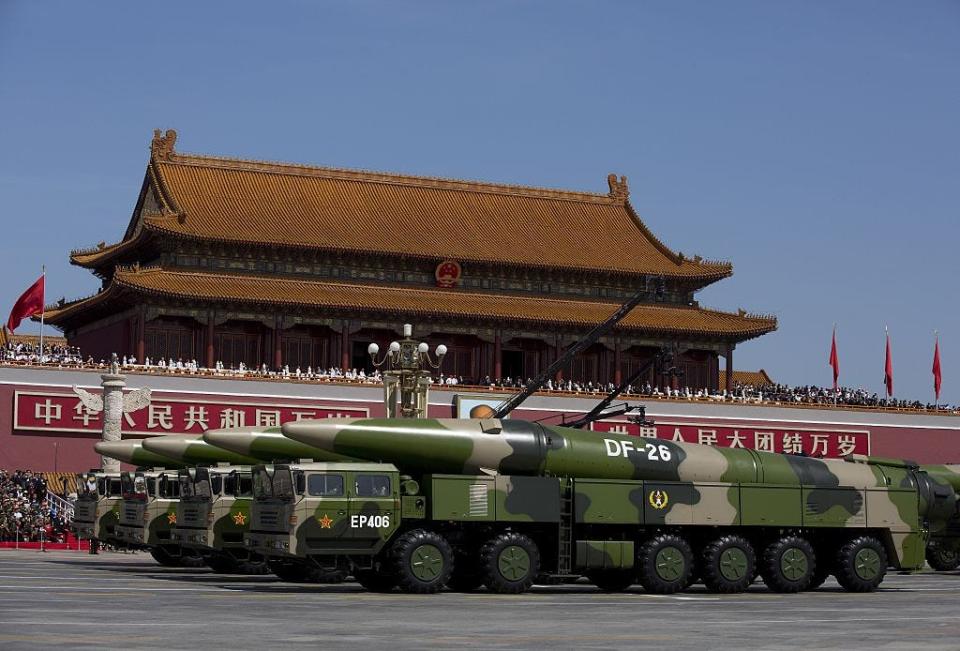China's rocket forces have been practicing launching 'carrier killer' missiles in the dark during midnight drills
China has been conducting midnight exercises to practice launching DF-26 missiles.
The DF-26, often described as a "carrier killer," can strike land and naval targets.
China's arsenal of missiles has led the US military to rethink certain war-fighting strategies.
The Chinese military has been practicing firing missiles in the dark, a more difficult task for troops than a daytime launch, Chinese state media reported this week.
The Chinese People's Liberation Army Rocket Force has been practicing carrying out simulated multi-wave ballistic-missile strikes in a series of recent midnight exercises, Global Times reported, citing a China National Radio report.
Col. Jiang Feng, the deputy commander of a missile brigade, told Chinese media that his forces "have been holding night exercises on a regular basis recently, which usually lasted past midnight. They featured the random changes of launch positions and targets, consecutive fire strikes and relocations."
Video footage from the exercises, which reportedly required troops to go through the firing process, relocate, reload, and then fire again, showed Chinese troops training with DF-26 intermediate-range ballistic missiles.

The DF-26 is road-mobile, ground-launched multi-role ballistic missile with an estimated range of about 2,500 miles, giving China the ability to strike Guam, a strategically valuable US territory in the Pacific.
The weapon was first revealed at a military parade in 2015 and then fielded the next year.
Because it can reach Guam, it has been referred to as the "Guam Killer" or "Guam Express," but the weapon is also referred to as a "carrier killer" because it has an anti-ship role like the DF-21D.
As the Department of Defense explained in its most recent assessment of China's military power, the DF-26 "is capable of conducting both conventional and nuclear precision strikes against ground targets as well as conventional strikes against naval targets."

Last summer, as two US Navy carrier strike groups conducted joint operations in the disputed South China Sea, the state-affiliated Global Times wrote that "China has a wide selection of anti-aircraft carrier weapons like DF-21D and DF-26 'aircraft carrier killer' missiles."
The Chinese outlet wrote that the "South China Sea is fully within the grasp of the Chinese People's Liberation Army (PLA), and any US aircraft carrier movement in the region is solely at the pleasure of the PLA."
The US Navy shrugged it off, saying that it is "not intimidated" by China's capabilities.
While China's growing missile arsenal has not deterred the US from operating in the area, it has led the US military to rethink the way it might wage war in the Pacific.

Recognizing that the DF-26 and other Chinese weapons have the ability to threaten important US bases and assets, as well as potentially cripple critical power-projection platforms like aircraft carriers, the US has been looking closely at force dispersal and new standoff capabilities.
In August, the Chinese military test-fired two DF-26 ballistic missiles into the South China Sea. Chinese forces also test-fired two DF-21D intermediate-range ballistic missiles.
US Navy Adm. Philip Davidson, then the head of US Indo-Pacific Command, said in March that China is trying to "send an unmistakable message" with this kind of exercise.
China, he said, "is not merely developing advanced weapons systems but is increasingly employing them in training and exercise scenarios to hone PLA warfighting skills and send an unmistakable message to regional and global audiences" about China's capabilities."
Read the original article on Business Insider

